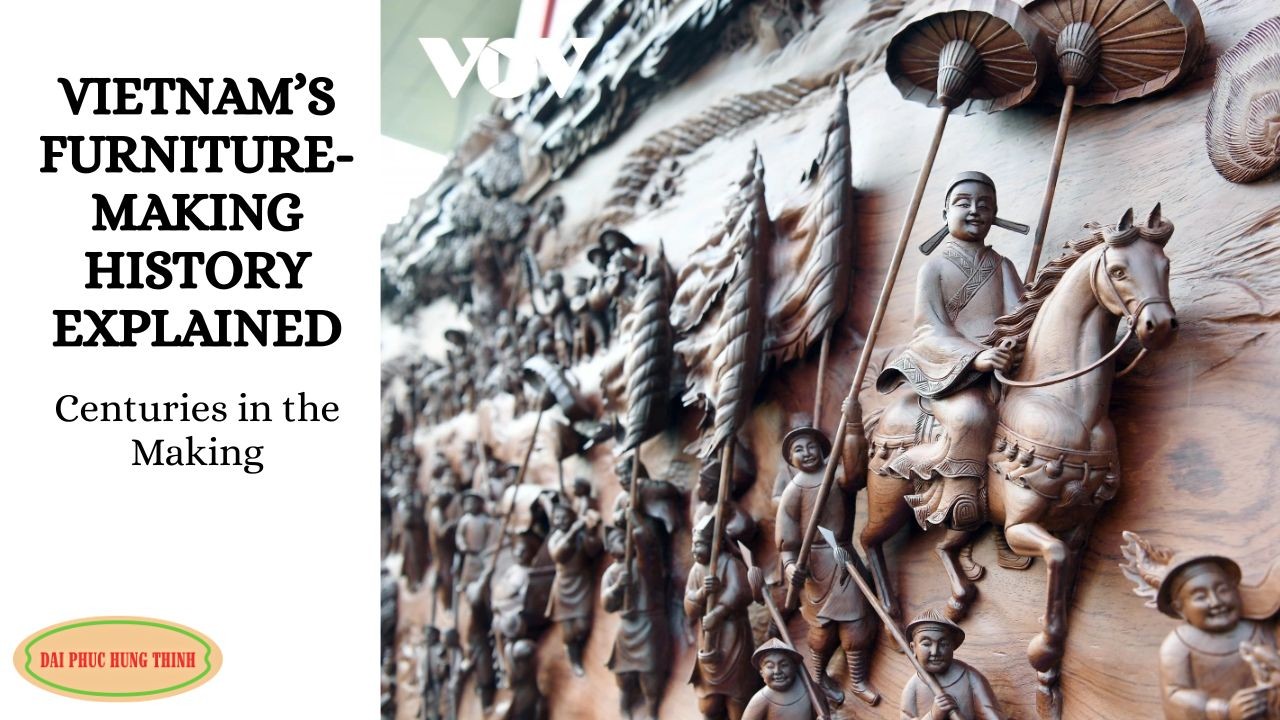When you see a beautifully crafted wooden chair labeled “Made in Vietnam,” what you’re looking at isn’t just a product—it’s the result of hundreds of years of craftsmanship, tradition, and quiet mastery.
What began in humble villages—where skilled artisans carved furniture by hand for local temples and homes—has evolved into a global phenomenon. Today, Vietnamese furniture graces homes, gardens, hotels, and resorts across Europe, North America, and beyond, admired not just for its value, but for its character.
Yes, Vietnam is known for its competitive prices and FSC-certified wood, but behind that is something far more compelling: a story of craftsmanship passed down through generations, and a culture where woodwork has always been more than just a job—it’s an art.
In this article, we’ll explore the roots and rise of furniture making in Vietnam—from ancient carpentry villages to the state-of-the-art factories that power today’s exports—so you can see why buyers around the world are drawn not just to the price, but to the story behind every piece.

A close-up look of “Vinh quy bái tổ” – the largest single-block wood relief carving in Vietnam. by Bùi Gia Wood Carving Studio recreates the scene and rituals of one of Vietnam's most iconic scholarly ceremonies — the Homecoming Ceremony of Honor, which celebrates the tradition of valuing education, respecting talent, and expressing gratitude toward one's homeland and origins. Source: VOV

Ancient Beginnings: The Craft That Built Communities
Vietnam’s furniture story began not in factories, but in villages, forests, and royal courts. As far back as the 10th century, Vietnamese ethnic groups built traditional homes from wood—longhouses, stilt houses, and three-room structures—crafted by local artisans using only hand tools and native timber.
The earliest recorded figure in Vietnamese carpentry is Ninh Hữu Hưng (936–1020), revered as the ancestor of the woodworking trade. Recruited by King Đinh Tiên Hoàng to build royal palaces, Hưng’s influence shaped not only imperial architecture but generations of craftsmen. His descendants settled in La Xuyên village (Nam Định Province), which is still known today as Vietnam’s oldest and most prestigious carpentry village.
 The ancient house in Củ Chi (Ho Chi Minh City) was built by carpenters from the Chàng Sơn craft village (Hanoi). Photo: Nguyễn Giang
The ancient house in Củ Chi (Ho Chi Minh City) was built by carpenters from the Chàng Sơn craft village (Hanoi). Photo: Nguyễn Giang
The Rise of Craft Villages: From Tools to Art
Over the following centuries, woodworking villages flourished across Vietnam—each specializing in distinct techniques and products:
La Xuyên (Nam Định) – Famous for intricate wood carving and inlay work
Vạn Điểm (Hà Nội) – Known for producing wooden tables and chairs in bulk
Liên Hà (Đan Phượng) – Specialized in beds, wardrobes, and household furniture
Mỹ Xuyên (Huế) – Developed fine wood sculptures and royal-style carvings
Kim Bồng (Quảng Nam) – Produced traditional statues and structural woodwork
Chàng Sơn (Thạch Thất) – Built heritage wooden homes for northern Vietnam
Hữu Bằng (Quốc Oai) – Excelled in wooden kitchenware and utilitarian crafts
Every nail, joint, and carving was made by hand, and each region developed its own design aesthetics based on local culture, beliefs, and available timber. These villages not only supplied their local communities but also became early hubs of commerce, with products traveling across provinces and even borders.
 The products from Hải Minh craft village (Nam Định) are all made from high-quality natural wood. Photo: Thanh Giang/VNP
The products from Hải Minh craft village (Nam Định) are all made from high-quality natural wood. Photo: Thanh Giang/VNP
Industrialization: From Hand Tools to Export Powerhouses
Until the 19th century, woodworking in Vietnam was almost entirely manual. But global shifts in manufacturing—especially the rise of mechanized joinery, drying kilns, and mass production—eventually found their way to Vietnam.
By the late 20th century, Vietnam began investing heavily in wood processing and export infrastructure. Traditional skills were merged with new technologies, creating a modern Vietnam furniture factory landscape. Today, there are more than 2,500 active furniture manufacturing companies in the country, including hundreds of foreign-invested enterprises.
Key furniture production hubs include:
Bình Dương & Đồng Nai – Industrial-scale Vietnam furniture manufacturers with containerized logistics
Quy Nhơn (Bình Định) – Outdoor furniture specialists close to acacia and eucalyptus plantations
Long An & Quảng Nam – Rapidly growing zones with strong automation adoption

Above: Dai Phuc Hung Thinh's factory in Qui Nhon, central Vietnam. Our main office is located in Ho Chi Minh City, southern Vietnam.
Global Growth: Vietnam’s Rise as a Furniture Export Leader
In the year 2000, Vietnam exported only $219 million worth of wood products. Fast forward two decades, and that figure has skyrocketed to over $10.5 billion, making Vietnam the second-largest exporter of wooden furniture in the world behind China.
Key reasons for this growth include:
1/ Skilled labor with deep craft traditions
2/ High availability of fast-growing, renewable timber like acacia and eucalyptus
3/ Wide adoption of FSC-certified wood sourcing
4/ Business-friendly policies and trade agreements
5/ Strategic participation in global sourcing events like VIFA EXPO, HawaExpo, and VIFA ASEAN
Even with this scale, many factories still operate with the values of transparency, family business ethics, and attention to detail—a legacy of Vietnam’s craft village culture.

Tradition Meets Technology
Vietnam’s furniture industry is a living example of how heritage and modernity can coexist. Today, it includes both:
1/ Family-owned workshops producing custom and small-batch orders
2/ Large-scale manufacturers exporting full container loads to major retailers
These factories serve a wide spectrum of buyers, from boutique shops in Europe to multinational chains in the U.S., with many now offering OEM/ODM services, private label production, and environmentally certified goods.
Final Thoughts: From La Xuyên to Your Living Room
Understanding the history of Vietnamese furniture making adds depth and context to every piece sourced from the country. It reveals a heritage of resilience, skill, and innovation—values that are still alive in the furniture being shipped around the world today.
At Dai Phuc Hung Thinh Furniture, we proudly carry on this tradition. Since 2003, our family-run furniture factory has specialized in high-quality outdoor wooden furniture made from 100% FSC-certified acacia and eucalyptus wood. We’ve supplied to respected retailers such as JYSK and Segmuller, and continue to serve clients across Europe and North America.
Whether you're a buyer looking to establish long-term sourcing relationships or a consumer interested in responsibly made furniture, you’re supporting a legacy that began over a thousand years ago.
📩 Contact us at: sales@daiphuchungthinh.com.vn
🌐 Visit us at: www.daiphuchungthinh.com.vn


